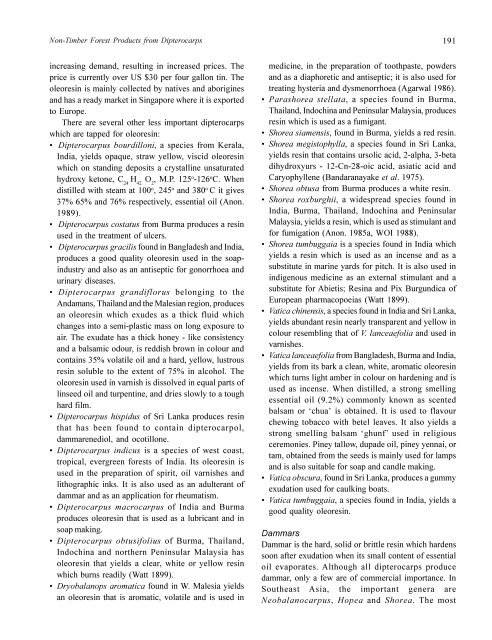A review of dipterocarps - Center for International Forestry Research
A review of dipterocarps - Center for International Forestry Research
A review of dipterocarps - Center for International Forestry Research
Create successful ePaper yourself
Turn your PDF publications into a flip-book with our unique Google optimized e-Paper software.
Non-Timber Forest Products from Dipterocarps<br />
increasing demand, resulting in increased prices. The<br />
price is currently over US $30 per four gallon tin. The<br />
oleoresin is mainly collected by natives and aborigines<br />
and has a ready market in Singapore where it is exported<br />
to Europe.<br />
There are several other less important <strong>dipterocarps</strong><br />
which are tapped <strong>for</strong> oleoresin:<br />
• Dipterocarpus bourdilloni, a species from Kerala,<br />
India, yields opaque, straw yellow, viscid oleoresin<br />
which on standing deposits a crystalline unsaturated<br />
hydroxy ketone, C H O , M.P. 125 24 42 2 o-126oC. When<br />
distilled with steam at 100o , 245o and 380o C it gives<br />
37% 65% and 76% respectively, essential oil (Anon.<br />
1989).<br />
• Dipterocarpus costatus from Burma produces a resin<br />
used in the treatment <strong>of</strong> ulcers.<br />
• Dipterocarpus gracilis found in Bangladesh and India,<br />
produces a good quality oleoresin used in the soapindustry<br />
and also as an antiseptic <strong>for</strong> gonorrhoea and<br />
urinary diseases.<br />
• Dipterocarpus grandiflorus belonging to the<br />
Andamans, Thailand and the Malesian region, produces<br />
an oleoresin which exudes as a thick fluid which<br />
changes into a semi-plastic mass on long exposure to<br />
air. The exudate has a thick honey - like consistency<br />
and a balsamic odour, is reddish brown in colour and<br />
contains 35% volatile oil and a hard, yellow, lustrous<br />
resin soluble to the extent <strong>of</strong> 75% in alcohol. The<br />
oleoresin used in varnish is dissolved in equal parts <strong>of</strong><br />
linseed oil and turpentine, and dries slowly to a tough<br />
hard film.<br />
• Dipterocarpus hispidus <strong>of</strong> Sri Lanka produces resin<br />
that has been found to contain dipterocarpol,<br />
dammarenediol, and ocotillone.<br />
• Dipterocarpus indicus is a species <strong>of</strong> west coast,<br />
tropical, evergreen <strong>for</strong>ests <strong>of</strong> India. Its oleoresin is<br />
used in the preparation <strong>of</strong> spirit, oil varnishes and<br />
lithographic inks. It is also used as an adulterant <strong>of</strong><br />
dammar and as an application <strong>for</strong> rheumatism.<br />
• Dipterocarpus macrocarpus <strong>of</strong> India and Burma<br />
produces oleoresin that is used as a lubricant and in<br />
soap making.<br />
• Dipterocarpus obtusifolius <strong>of</strong> Burma, Thailand,<br />
Indochina and northern Peninsular Malaysia has<br />
oleoresin that yields a clear, white or yellow resin<br />
which burns readily (Watt 1899).<br />
• Dryobalanops aromatica found in W. Malesia yields<br />
an oleoresin that is aromatic, volatile and is used in<br />
191<br />
medicine, in the preparation <strong>of</strong> toothpaste, powders<br />
and as a diaphoretic and antiseptic; it is also used <strong>for</strong><br />
treating hysteria and dysmenorrhoea (Agarwal 1986).<br />
• Parashorea stellata, a species found in Burma,<br />
Thailand, Indochina and Peninsular Malaysia, produces<br />
resin which is used as a fumigant.<br />
• Shorea siamensis, found in Burma, yields a red resin.<br />
• Shorea megistophylla, a species found in Sri Lanka,<br />
yields resin that contains ursolic acid, 2-alpha, 3-beta<br />
dihydroxyurs - 12-Cn-28-oic acid, asiatic acid and<br />
Caryophyllene (Bandaranayake et al. 1975).<br />
• Shorea obtusa from Burma produces a white resin.<br />
• Shorea roxburghii, a widespread species found in<br />
India, Burma, Thailand, Indochina and Peninsular<br />
Malaysia, yields a resin, which is used as stimulant and<br />
<strong>for</strong> fumigation (Anon. 1985a, WOI 1988).<br />
• Shorea tumbuggaia is a species found in India which<br />
yields a resin which is used as an incense and as a<br />
substitute in marine yards <strong>for</strong> pitch. It is also used in<br />
indigenous medicine as an external stimulant and a<br />
substitute <strong>for</strong> Abietis; Resina and Pix Burgundica <strong>of</strong><br />
European pharmacopoeias (Watt 1899).<br />
• Vatica chinensis, a species found in India and Sri Lanka,<br />
yields abundant resin nearly transparent and yellow in<br />
colour resembling that <strong>of</strong> V. lanceaefolia and used in<br />
varnishes.<br />
• Vatica lanceaefolia from Bangladesh, Burma and India,<br />
yields from its bark a clean, white, aromatic oleoresin<br />
which turns light amber in colour on hardening and is<br />
used as incense. When distilled, a strong smelling<br />
essential oil (9.2%) commonly known as scented<br />
balsam or ‘chua’ is obtained. It is used to flavour<br />
chewing tobacco with betel leaves. It also yields a<br />
strong smelling balsam ‘ghunf’ used in religious<br />
ceremonies. Piney tallow, dupade oil, piney yennai, or<br />
tam, obtained from the seeds is mainly used <strong>for</strong> lamps<br />
and is also suitable <strong>for</strong> soap and candle making.<br />
• Vatica obscura, found in Sri Lanka, produces a gummy<br />
exudation used <strong>for</strong> caulking boats.<br />
• Vatica tumbuggaia, a species found in India, yields a<br />
good quality oleoresin.<br />
Dammars<br />
Dammar is the hard, solid or brittle resin which hardens<br />
soon after exudation when its small content <strong>of</strong> essential<br />
oil evaporates. Although all <strong>dipterocarps</strong> produce<br />
dammar, only a few are <strong>of</strong> commercial importance. In<br />
Southeast Asia, the important genera are<br />
Neobalanocarpus, Hopea and Shorea. The most

















